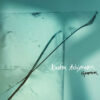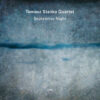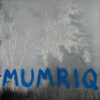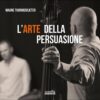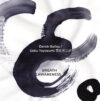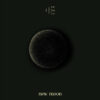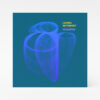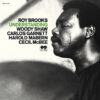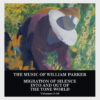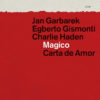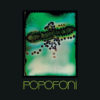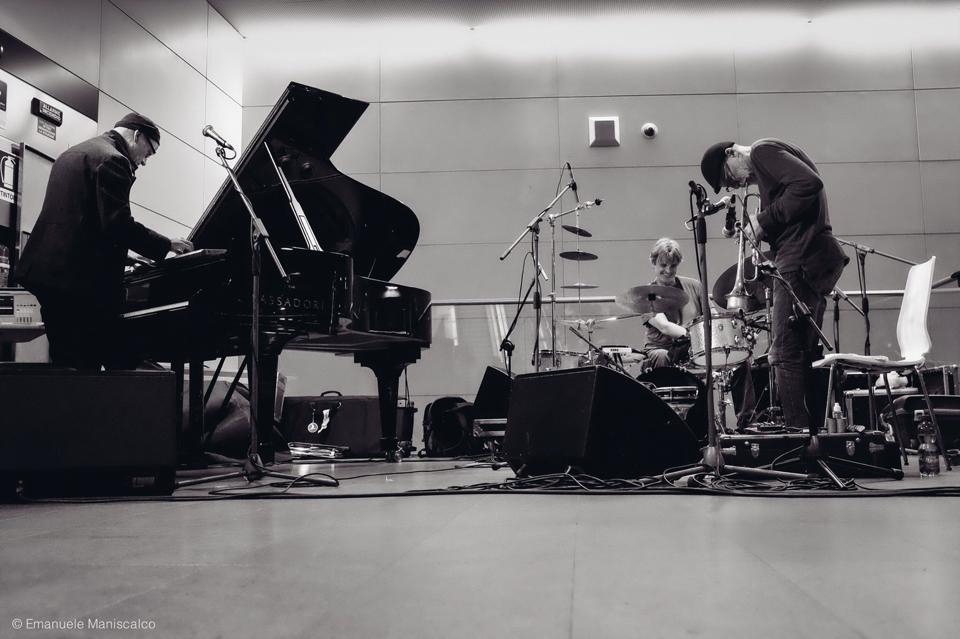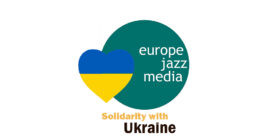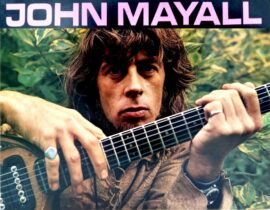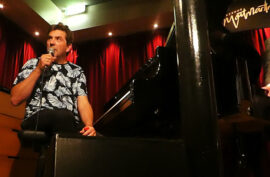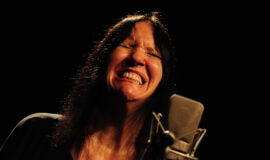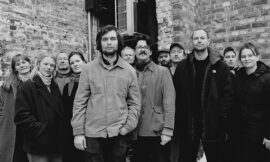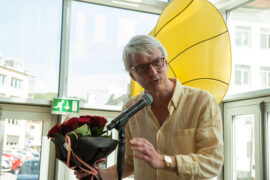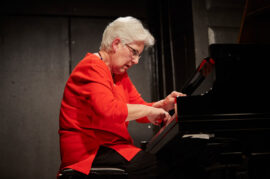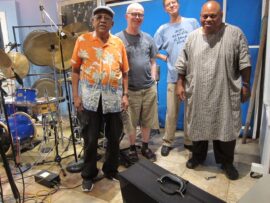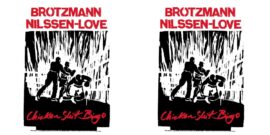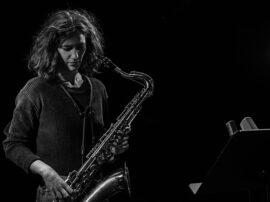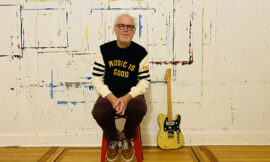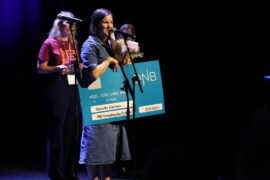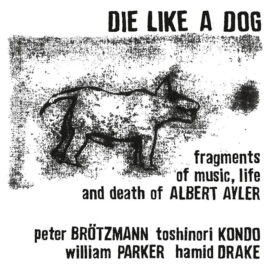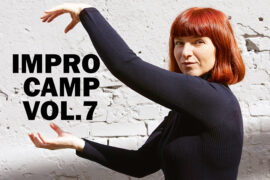The trio Jøkleba, with Per Jørgensen on trumpet, vocal and more, Audun Kleive on percussion and Jon Balke on keyboards, has recently been reborn after a ten-year hiatus. Following up on their almost legendary status as formulators of a unique and instantaneously composed musical language during the early 1990s, the trio has further developed its approach to the performance of improvised music, adapted to the musical contexts of the 2010s.
This autumn they launched their new record Outland on ECM, a record that immediately was described as one of the major international jazz releases of 2014.
In line with the members’ individual convictions of the necessity of changing life styles towards environmentally sustainable patterns of behaviour, they chose to make the trio’s touring in 2014 into a test bed of new eco-touring.
Their ideas was as simple to formulate as it proved difficult to perform:
All touring in 2014 done with the smallest possible CO2 footprint.
Playing on the band name the tour was launched as the Jøkleba 2014 JØKoToUR. Early on they learned that Jøko-touring was not just a question of choosing to travel by trains in place of air travel. European transport policies, the accessibility of relevant information – as well as other socio-economic policies – did their utmost to put spanners into the touring operations of Jøkleba.
From Bodø to Bristol
The idea of a Jøkotour was born from the trio’s collaboration with urban development architects involved in the «Future Built» programme (see futurebuilt.no), dedicated to architecture and sustainable urban development. Though musicians travel constantly, questions of culture travels, touring and sustainability are not high on the agenda on the professional music scenes. Checking CO2 emissions by just one flight Oslo-Rome compared to the emissions from travelling the distance by train, one immediately feels an urge to awaken our consciousness about the carbon footprints of concert performances worldwide.
With Jøkleba’s history of combining musical exploration with dynamic conceptual ideas, the Jøkotour brought a visual world of sustainable future architecture and urbanism. The band’s tours of 2012 investigated the implementation of improvised visual scenography, sound imagery and a visual production of architectonic elements. This experience provided the basis for the 2014 Jøkotour.
At the conference «FutureBuilt2013» Jøkleba premiered the concept of a Jøkotour as a performative synthesis of sound, space and environmental thinking. In a scenography of live visuals based on architectural project drawings, the trio worked in soundscapes of extended simulated spaces.
The opening concert of the Jøkotour was in Bodø in the north of Norway in March 2014. From Bodø the Jøkotour went all the way to Istanbul, returning via Italy and Germany to the UK and then back to Norway.
The objective of the tour was that all transport related to the concerts should utilize transport modes with zero or ultralow CO2 emissions. This meant that venues reachable by train with electric traction would be preferred. Concert venues that are unreachable by other means than air flights or road transport by fossil fuels, would not be considered.
They started with a Norwegian mini-tour in the spring of 2014, a tour that already faced a few of the challenges that became more prominent on the trans-European rail express(?) way. With these initial experiences they followed up with a trans-European Jøkotour in November 2014. From Bodø, via Istanbul, to the UK before returning to Norway.
For the trans-European tour Jon Balke agreed to report on the progress of the Jøkotour for salt peanuts*. Here is his report.
The Jøkotour report
Environmental accounts of transport are generally based on the carbon footprint, as measured by CO2 emissions per passenger and kilometre.
Rail transport based on electric traction is the winner in most tables available on the net. Most of these tables allow for adjustment for variables such as the number of passengers per travelling leg, whether it’s based on electrical or diesel traction, and if electrical, on what basis the electrical energy is generated, such as coal-based, nuclear or hydropower generation.
On many specific hauls these additional variables have a large impact, at times so large that it may be uncertain what travel mode is the best, i.e. has the lowest carbon emission. On many stretches the difference between a fully seated or an half-empty bus or train may be what shifts the environmental advantage from one mode to another. Even a sedan with three persons may score high compared to trains, and may surpass bus transport as measured by CO2 per passenger-kilometre on certain routes.
The Norwegian tour was done by travelling with NSB, the national railroad company. Generally this is very good – not the least because electric energy is generated by hydropower. However, the Bodø-Trondheim line is run with diesel traction. Why is it so, Jernbaneverket/Norwegian Rail Administration?
The day before we set out on our long European Jøkotour, they closed the night train from Copenhagen through Germany. From January next year several other night train hauls in Central Europe are closed as well. It is a shame!
Let us dive into the details.
With cancelled concerts in Copenhagen, Berlin and Vienna, the first tour concerts was in Istanbul. This followed immediately after rehearsals at the eco-music centre Madstun, not far from Oslo.
Nov. 5 Oslo – Istanbul:
By train the stretch is about 50% longer than with a direct air flight. No reliable information can ensure us whether the trains are run on electrical or diesel traction, nor can they tell us the source of the electrical energy. On the other hand Turkish Airlines flies directly from Oslo to Istanbul with fully seated planes.
Ergo: It is impossible to conclude reliably whether there are any environmental benefits with travelling by train on this leg of the tour. We flew the distance.
For the rest of the Jøkotour we used InterRail tickets, first class.
Nov. 9 Istanbul – Beograd
The first part of the line was closed due to work on the line. Ten hours on bus for a charge of 70 Turkish lire per man.
100 km of the train haul from Sofia to Belgrade is diesel powered. And nobody knows the generating source of the electricity for the other distances. Coal, nuclear, hydroelectric? It might change by the second, on the whims of the market prices.
Hard bunks on a rattling train.
Nov. 10 Beograd – Villach
First class Belgrade – Villach was cancelled. More: The train moved 40 meters, stopped for 20 minutes, moved another 150 meter, ten minutes halt, then moving another kilometre, … and so on.
We were later told that the reason was an ongoing strike within the rail authority in Serbia. We had been physically blocked by a hundred rail road workers just outside of the Belgrade central station. The further stops were caused by red lights – used as part of a go-slow action.
Of course we got no information. We only got stone faces, coming to check our tickets and passports at every border crossing.
Total delay is 50 minutes at the border of Croatia, time 14.20.
No restaurant car, no trolley service. We had to sit for eight hours without food and water, before I succeeded in jumping off the train and sprint to the bakery at the Zagreb station.
Nov. 11 Villach -Venezia
First class, serving and smooth wheels on polished rails.
Nov. 11 Venezia – Bologna
We entered first class. The ticket lady charge us 18 euros for every seat, as we hadn’t done our seat reservations at the station. We didn’t need this!
Along the way we discovered the Deutsche Bahn Navigator (see bahn.de/db-navigator) – a fantastic app for European rail transport. Together with CityMaps2Go (see ulmon.com), this gave us full control.
Nov. 14 Bologna
General strike in Italy. Mayhem at Bologna Centrale. There are strikes and demonstrations against the labour policies of the government all over Italy.
Nov. 15 Parma – Brescia
Diesel train. 116 km.
Afternoon concert at the San Faustino station of the automatic, driverless Brescia metro (picture).
Nov. 16 Night train Brescia – München
A total cultural revolution. A professional looking train, with a very brusque gentleman giving us a lecture of an almost military precision on how everything works. Our choices were simple: wake-up at 05.30 or 06.00. No other choices available. Apart from this, everything else was stated as orders.
The train was halted in Verona for almost an hour, connecting and de-connecting cars. Still we were in Munich on time, almost at the second, at 06.30 am – in spite of the delay out of Brescia and all the waiting in Verona.
Nov. 16 München – Köln
With ICE 612. Nice seats, wide leg room, coffee, newspapers, power sockets for the laptops at every seat, top speed 300 km/h, no sounds. 4.5 hours.
Nov. 19 Köln – Brussel
Thalys 1448 from Cologne to Brussels: smooth, with servings of lunch and coffee. Arrival on the minute by the time table.
Nov. 19 Brussel – London
Eurostar: Battered train – an ordinary standard train set with a simple buffet service. Just like the Oslo – Bergen line, though this one is packed with blasted Englishmen.
Disappointing trip, considering the price. Stern check-in, with passport control. And my synth had to be sent as separate luggage for 20 euros.
Nov. 21 London – Bristol
Diesel, once again! aaarggh…
Nov. 23 Bristol – Reading
Diesel! Fuck…
For the return trip from London, see jokleba.no.
Conclusions in short
Using trains in Europe is ingenious – and it is a reliable mode of transport. But long hauls do not work due to the cancellation of night trains. Towards the east in Europe, though, things get harder to predict. If you are on tour and need to be somewhere on time for a stage rig or sound check, you should have a wide room for adjustments at both ends of the stretch.
In addition it proved difficult to get confirmations of the environmental benefits we achieved.
Mentally and socially it is a fruitful and smart way of touring. Actually, we did not get exhausted, but sailed pretty well rested through Europe. That is, apart from the night on hard bunks in Serbia. To toil and sweat, to queue up at an airport, sounds completely weird now.
This was a test project, based on the simple question – how would it work if we did it like this? Of course, in future there will be a range of more utilitarian considerations that will shape the choice of transport modes. But if the network of arrangers and promoters join in and collaborate, we could achieve tours that score very high on environmental benefits when the gigs are stringed along a rail road line, more or less one after the other, without too long hauls…
How about it, Euro Jazz Network?
Text: Jon Balke/Johan Hauknes
Photo: Emanuele Maniscalco

